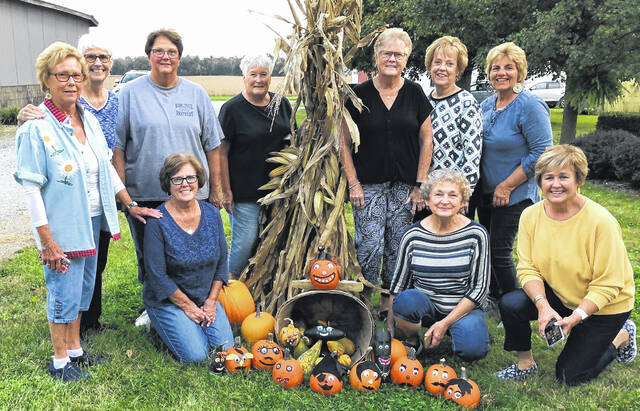
Fall and frost have just joined us for awhile, but you can still see lots of pumpkins still around. Soon, some will turn into delicious soups, pies, cheese cakes, and parts of cornucopias and other fall decorations. What are these yummy fruits and where did they come from?
Eleven Deercreek Daisies found out in late October and turned them into some comical, cute, or just a little crazy design. In Marty Cook’s garage, they picked a simple pumpkin/gourd and each used their creative genius to come up with the views you see here. Using felt-paint-buttons-google eyes and more, the lowly fruits took on new personalities. You’ll notice they are all shapes and colors.
Many Daisies picked sugar pumpkins, they are better for eating/cooking and are less stringy. They listened to the “Legend of Stingy Jack” while they worked, and learned the origin of the Jack-0-Lantern. You can look it up for next year.
But where did PUMPKINS really come from you ask? The name pumpkin is derived from the Greek word pepon, which translates to large melon. It belongs to the gourd family and its flowers are edible. Scientifically speaking, pumpkins are a fruit (they contain seeds), but when it comes to cooking, they are often referred to as vegetables.
Over 1 billion pounds (450 million kgs) of pumpkin are produced in the US every year. Illinois grows more pumpkins than any other state. They vary in weight, but an average sized pumpkin might weigh around 13 pounds (six kilograms) and it takes 110 days for a typical carving pumpkin to be full grown for Halloween. Pumpkin plants feature both male and female flowers, with bees typically being involved in pollination (the transfer of pollen).*
The flesh of pumpkins is high in Vitamin A and potassium and contains three grams of fiber per cup when cooked. Pumpkins are rich in beta carotene, it is an antioxidant that your body converts to Vitamin A, which may help preserve the health of your eyes, lungs, and heart. Pumpkin seeds are a valuable source of magnesium, which can help keep your blood pressure in healthy range. Pumpkin seeds inside are rich in heart healthy unsaturated fats, as well as protein and Vitamin E. Pumpkin seeds are called “pepitas.” One hundred grams of pumpkin produces around 26 calories of energy.* So, enjoy that pumpkin pie!
*Source: Harvard Women’s Health Watch Oct. 2022


